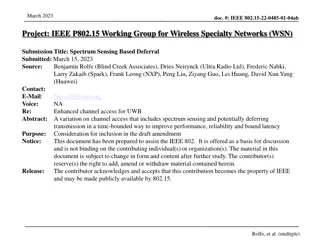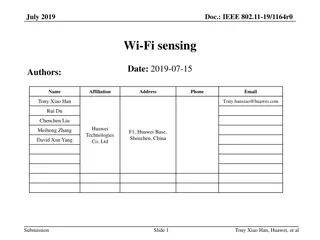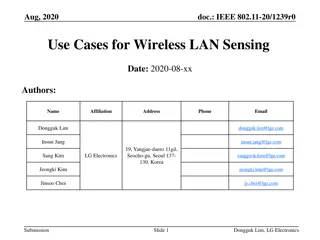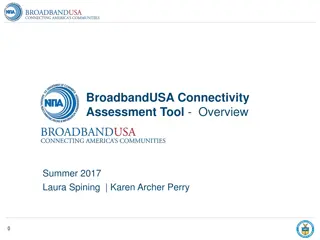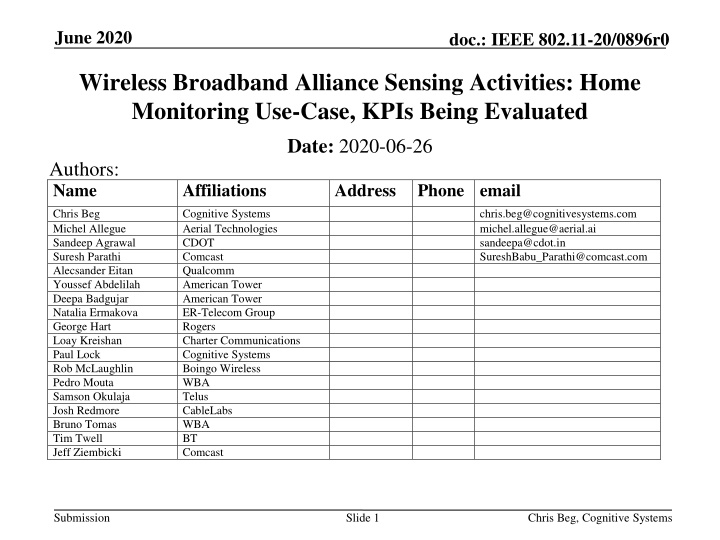
Wireless Broadband Alliance Sensing Activities for Home Monitoring Use-Case
This document explores the implementation of KPIs for home monitoring use-cases within the IEEE and WBA framework. It discusses the historical background, challenges, and the application of Wi-Fi sensing systems for various purposes, including motion detection and health monitoring. The document outlines the collaboration among industry experts to enhance existing MAC/PHY standards for better efficiency.
Download Presentation

Please find below an Image/Link to download the presentation.
The content on the website is provided AS IS for your information and personal use only. It may not be sold, licensed, or shared on other websites without obtaining consent from the author. If you encounter any issues during the download, it is possible that the publisher has removed the file from their server.
You are allowed to download the files provided on this website for personal or commercial use, subject to the condition that they are used lawfully. All files are the property of their respective owners.
The content on the website is provided AS IS for your information and personal use only. It may not be sold, licensed, or shared on other websites without obtaining consent from the author.
E N D
Presentation Transcript
June 2020 doc.: IEEE 802.11-20/0896r0 Wireless Broadband Alliance Sensing Activities: Home Monitoring Use-Case, KPIs Being Evaluated Date: 2020-06-26 Authors: Name Affiliations Address Phone email Chris Beg Michel Allegue Sandeep Agrawal Suresh Parathi Alecsander Eitan Youssef Abdelilah Deepa Badgujar Natalia Ermakova George Hart Loay Kreishan Paul Lock Rob McLaughlin Pedro Mouta Samson Okulaja Josh Redmore Bruno Tomas Tim Twell Jeff Ziembicki Cognitive Systems Aerial Technologies CDOT Comcast Qualcomm American Tower American Tower ER-Telecom Group Rogers Charter Communications Cognitive Systems Boingo Wireless WBA Telus CableLabs WBA BT Comcast chris.beg@cognitivesystems.com michel.allegue@aerial.ai sandeepa@cdot.in SureshBabu_Parathi@comcast.com Submission Slide 1 Chris Beg, Cognitive Systems
June 2020 doc.: IEEE 802.11-20/0896r0 Abstract This contribution proposes a list of KPIs for Home Monitoring Use-Case Submission Slide 2 Chris Beg, Cognitive Systems
June 2020 doc.: IEEE 802.11-20/0896r0 Outline Brief History within WBA Generic Wi-Fi Sensing Systems Comparison to Other Wi-Fi Services Home Monitoring Use-Case KPIs Being Evaluated Usage of Existing MAC/PHY Standards Challenges Faced References Submission Slide 3 Chris Beg, Cognitive Systems
June 2020 doc.: IEEE 802.11-20/0896r0 Brief History within WBA A workgroup specific to Wi-Fi Sensing discussions was officially formed January 2019 First output of group was a whitepaper introducing the technology along with business opportunities https://wballiance.com/wba-wi-fi-sensing/ The group has started a second phase project, focused on application layer topics surrounding testing for a Home-Monitoring use-case. https://wballiance.com/wba-wi-fi- sensing/ Submission Slide 4 Chris Beg, Cognitive Systems
June 2020 doc.: IEEE 802.11-20/0896r0 Generic Wi-Fi Sensing Systems Uses for Sensing is very broad [1]-[5] Home Monitoring (Motion Detection) Health-Care and Monitoring Gesture Detection (smart control) Many Others Sensing occurs above MAC/PHY [6] PHY data (CSI) is extracted from radio Processed by algorithm within an agent Agent output enables application/service Works along side existing services Agent may be added to AP, or STA [1] WBA Wi-Fi Sensing Whitepaper Submission Slide 5 Chris Beg, Cognitive Systems
June 2020 doc.: IEEE 802.11-20/0896r0 Comparison to Other Wi-Fi Services Wi-Fi Sensing is just a new type of service As an example, compare Hotspot 2.0 to Home-Monitoring Both provide service to end user (automatic roaming vs home insight) Both reside in an agent above the MAC/PHY layer (hostapd vs sensing agent) Both extend 802.11 base components (discovery/association vs channel estimation) Difference is Wi-Fi Sensing is still emerging Hotspot 2.0 benefits from standardization (802.11u discovery features, 802.11i WPA2) Hotspot 2.0 uses defined information elements for data exchange (WFA Defined) Submission Slide 6 Chris Beg, Cognitive Systems
June 2020 doc.: IEEE 802.11-20/0896r0 Home Monitoring Use-Case Algorithm designed to detect motion in home (2.4G / 5G / 6G) Extra features such as localization are also present Enhancements to filter false detections from pets / shadows / moving objects Output typically sent to cloud, and accessible via mobile app Many useful features can be derived from motion Alerts/alarm when unexpected motion detected in house Historical data Interaction with other IoT devices Technology provides many benefits Does not require LoS (PIR sensors and cameras) Privacy concerns (cameras) Algorithms to minimize potential false detections Chris Beg, Cognitive Systems Submission Slide 7
June 2020 doc.: IEEE 802.11-20/0896r0 KPIs Being Evaluated Base Motion Sensing Performance Metrics Characterization of algorithm s ability to minimize false-detects and maximize correct-detections Sensing Latency Delay and Decay Measurement of time for algorithm s prediction to match reality Sensing Stationary/Static Environment Long term stability in environment where there is no motion Motion Resolution Ability to detect small vs large vs fast vs slow human motion Floor Coverage and Surface Area Coverage of entire environment with a given number of devices Submission Slide 8 Chris Beg, Cognitive Systems
June 2020 doc.: IEEE 802.11-20/0896r0 KPIs Being Evaluated Sensing Location Accuracy Ability of algorithm to determine physical location of motion Sensing With Interference Reduction in sensitivity due to electrical, mechanical, or network load interference Network Performance Measurement of network resources utilized for Sensing Computation Resources Evaluation of CPU/memory resource requirements to implement Agent Submission Slide 9 Chris Beg, Cognitive Systems
June 2020 doc.: IEEE 802.11-20/0896r0 Usage of Existing MAC/PHY Standards Eliciting measurement from another STA Various mechanisms in existing standard used for this purpose Null-Data frame transmission and ACK response LTS in ACK used to provide CSI Pro: Protocol contained in MAC layer Con: Limitation is ACKs are legacy and MIMO CSI not possible Existing application data traffic Relies on data communication, or application layer data transmission Pro: MIMO CSI is possible Con: Solution spans many layers (up to application layer) Con: Higher overhead and less deterministic behaviour Submission Slide 10 Chris Beg, Cognitive Systems
June 2020 doc.: IEEE 802.11-20/0896r0 Challenges Faced No standardized protocol for eliciting measurements Periodic measurements generally performed Air time efficiency, regular scheduled intervals MIMO or Legacy CSI Need to ensure static configuration for transmission (beamforming) Device participation and capability exchange Not every device will want to participate (e.g., battery operated) No common radio API and interface among chipsets Results in duplication of code that could be made common Submission Slide 11 Chris Beg, Cognitive Systems
June 2020 doc.: IEEE 802.11-20/0896r0 References [1]. https://wballiance.com/wba-wi-fi-sensing/ [2] Wi-Fi sensing: Usages, requirements, technical feasibility and standards gaps IEEE 802.11-19/1293r0 [3] 802.11 Sensing: Applications, Feasibility, Standardization, IEEE 802.11- 19/1626r0 [4] Wi-Fi Sensing Application: Multipath Enhanced Device free Localization, IEEE 802.11-19/1580r0 [5] Wi-Fi Sensing: Technical Feasibility, Standardization Gaps, IEEE 802.11- 17/1803r0 [6] WLAN Sensing Definitions, IEEE 802.11-20/0807r1 Submission Slide 12 Chris Beg, Cognitive Systems





